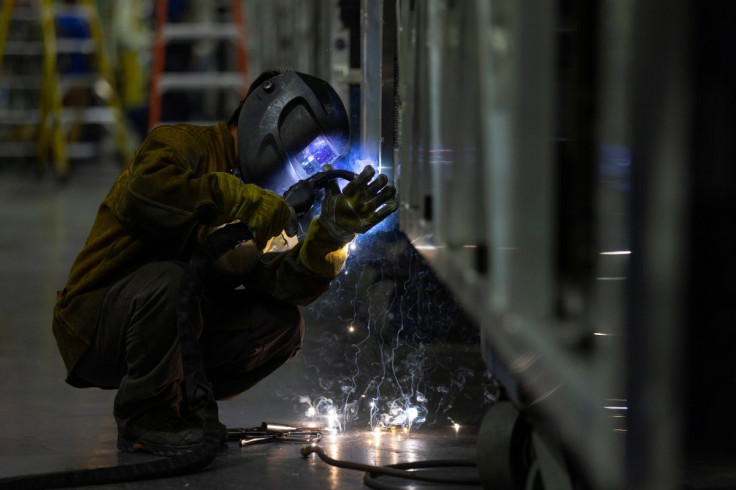U.S. Labor Costs Rise Strongly In Second Quarter

U.S. labor costs increased strongly in the second quarter as a tight jobs market continued to boost wage growth, which could keep inflation elevated and give the Federal Reserve cover to continue its aggressive interest rate hikes.
Other data on Friday showed consumer spending accelerating in June, though the uptick was tied to higher costs for gasoline as well as a range of other goods and services, with monthly prices surging by the most since 2005. Soaring inflation contributed to the economy's contraction in the first half of this year, leaving it on the brink of a recession.
"The Fed will continue to grapple with trying to tame inflation without tipping the economy into a recession," said Dante DeAntonio, an economist at Moody's Analytics in West Chester, Pennsylvania "The data on wage and price growth will not do them any favors as upward pressure clearly remains even as the overall economy has weakened."
The Employment Cost Index, the broadest measure of labor costs, increased 1.3% last quarter after accelerating 1.4% in the January-March period, the Labor Department said.
Economists polled by Reuters had forecast the ECI would rise 1.2% in the second quarter. Labor costs surged 5.1% on a year-on-year basis, the largest rise since the current series started in 2001, after increasing 4.5% in the first quarter.
The ECI is widely viewed by policymakers and economists as one of the better measures of labor market slack and a predictor of core inflation, as it adjusts for composition and job-quality changes. It is being closely watched for signs of whether wage growth has peaked as economists and investors try to gauge the pace of the Fed's interest rate hikes.
The U.S. central bank on Wednesday raised its policy rate by another three-quarters of a percentage point. It has now hiked that rate by 225 basis points since March.
There have been mixed signals on wages. While annual growth in average hourly earnings in the Labor Department's monthly employment report slowed in the first half of the year, the Atlanta Fed's wage tracker accelerated.
The Fed's "Beige Book" report this month showed that "most districts continued to report wage growth," and "a quarter of districts indicated wage growth will remain elevated for the next six months."
There were 11.3 million job openings at the end of May, with nearly two open positions for every unemployed person.
Employment costs were boosted by strong wage gains. Wages and salaries shot up 1.4% in the second quarter after rising 1.2% in the first quarter. They were up 5.3% on a year-on-year basis.
The private sector was the main driver of the increase, with wages and salaries there notching a 1.6% increase in the second quarter, up from 1.3% in the January-March period.
U.S. stocks opened higher. The dollar rose against a basket of currencies. U.S. Treasury prices fell.
INFLATION HEATS UP
In a separate report on Friday, the Commerce Department said consumer spending, which accounts for more than two-thirds of U.S. economic activity, rose 1.1% last month after gaining 0.3% in May. Economists had forecast consumer spending would accelerate by 0.9%.
The data was included in the advance gross domestic product report for the second quarter, which was published on Thursday. That report showed inflation-adjusted consumer spending increased at its slowest pace in two years amid declines in purchases of goods, particularly food, because of higher prices.
Gross domestic product contracted at a 0.9% annualized rate last quarter after falling at a 1.6% pace in the first quarter. The economy shrank 1.3% in the first half of the year.
Consumer spending last month was inflated by higher prices for gasoline and other energy products. Consumers also spent more on healthcare and motor vehicles.
The higher costs boosted the personal consumption expenditures (PCE) price index 1.0% last month. That was the largest increase since September 2005 and followed a 0.6% gain in May. In the 12 months through June, the PCE price index advanced 6.8%, the largest increase since January 1982. The PCE price index rose 6.3% on a year-on-year basis in May.
Excluding the volatile food and energy components, the PCE price index shot up 0.6% after climbing 0.3% in May. The so-called core PCE price index increased 4.8% on a year-on-year basis in June after rising 4.7% in May.
These measures are closely tracked by Fed officials for the central bank's 2% inflation target. With prices soaring, inflation-adjusted consumer spending rebounded by a feeble 0.1% in June after falling 0.3% in May. This puts consumer spending on a weak growth trajectory heading into the third quarter.
© Copyright Thomson Reuters 2024. All rights reserved.





















